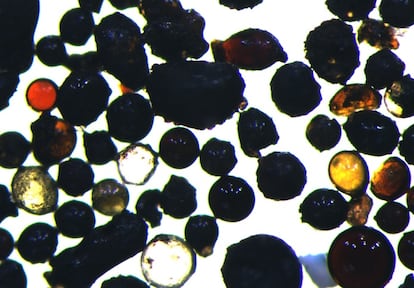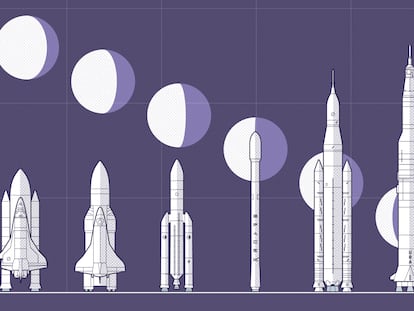Chinese scientists discover new water reservoir on the Moon
The ‘Chang’e 5′ probe has found that impact glass beads on the lunar surface contain the precious resource

Less than two years ago, China took a small but significant step in its goal of becoming a space power. For the first time, the Asian giant sent a robotic spaceship to Oceanus Procellarum (Latin for “Ocean of Storms”), a vast lunar mare that looks like a huge dark spot from Earth. According to the China National Space Administration, it is the youngest terrain on the Moon. China’s Chang’e 5 probe landed near Mount Rümker, a 43-mile-long (50 kilometer) mass that rises around a mile above the horizon. It used a robotic arm to take lunar samples and send them to the orbital module over the Moon. From there, they were dispatched back to Earth. All this took place in a single lunar day: the equivalent to around 14 Earth days.
The analysis of these samples — the first lunar samples collected since the Soviet mission Lunik 24 in 1976 — has now revealed some surprising results. The Chinese space agency believes it has solved one of the biggest mysteries surrounding the Moon: where does lunar water come from?
The Moon likely formed when a planet the size of Mars crashed into Earth more than four billion years ago. The collision broke off a piece of the Earth, and covered it with molten rock. The temperatures were thought to have been so high that all water evaporated forever.
However, in recent years, several robotic missions and terrestrial telescopes have confirmed that the Moon continues to contain water — and not just a few drops: there are tons of water in the form of ice. Much of this water is located at the poles, shrouded in perpetual darkness. It is precisely in these unexplored regions where NASA plans to land the first crewed mission to the Moon in 50 years. The mission is landing there because the area contains water, and with it possible sustenance and raw material for rocket fuel to help the crews that one day may reach Mars.
Until now, it was not known where this frozen water came from. Other space probes have also found ice in the illuminated areas of the Moon, but were not able to determine how it got there, with researchers suggesting it may have arrived via an asteroid or a previously undetected water reservoir.
In a study published on Monday, scientists from the Chinese Academy of Sciences (CAS) in collaboration with two European researchers, argue that the secret to the origin of lunar water lies in the samples sent by Chang’e 5. These samples — collected from the northwest of the Moon — contain impact glass beads, i.e. small grains of different colored glass that probably formed at high temperatures after a meteorite collided with the Moon. According to the study, published in the journal Nature Geoscience, these glass beads collected by Chang’e 5 contain small amounts of water.

Sen Hu, from the Planetary Physics Laboratory at CAS, explains that the water content in the crystals is about 2,000 parts per million, or about 2,000 grams for every ton of soil. “On the Moon, meteorite impacts are very frequent and occur across the Moon, meaning glass beads are distributed throughout its geography, from the equator to the polar regions,” Hu told EL PAÍS. According to the scientist, the lunar water may be in its molecular state (two hydrogen atoms and one oxygen atom), although so-called hydroxyl (one hydrogen and one oxygen atom) is probably more abundant.
Researchers estimate that 270 billion tons of water may be stored across the Moon in the form of impact glass beads. This is a huge reservoir compared to other estimates. In 2010, for example, a NASA radar aboard the Indian probe Chandrayaan-I estimated that there were about 600 million tons of ice entombed in craters at the Moon’s north pool.
The samples taken by the Chinese spacecraft are about a billion years younger than those collected by astronauts in the U.S. Apollo program and the Soviet Union’s robotic missions. The latest study shows that these glass beads have been forming for the past two billion years, with more produced during periods of intense meteorite collisions, such as the one that occurred 68 million years ago, when a large meteorite struck Earth and wiped out the dinosaurs.
What’s interesting, says Hu, is that the water locked up in the lunar crystals has been generated by the Sun. An analysis of the different types of hydrogen atoms in the samples suggests that positively charged hydrogen atoms from a solar wind penetrated the glass beads and combined with the oxygen inside them. When the temperature is high enough due to solar radiation, these glass beads could also release part of their H₂O charge. “These glass beads are responsible for the water cycle on the Moon,” he explained.
“This could be an alternative source of water,” Hu added. “The way to extract it would be to collect lunar soil, heat it in an oven at 100 degrees Celsius and capture the resulting steam.”
While it may sound crazy, Europe’s Prospect spacecraft is being sent to the Moon to do just that. A probe will drill into the lunar soil, collect samples and heat them up to 100 degrees to study the volatile compounds present, including water vapor. “This project, which we will launch in 2026, can clarify whether there is water trapped in the minerals on the Moon,” James Carpenter, head of planetary sciences at the European Space Agency (ESA), told EL PAÍS.
According to Carpenter, the new China-led study provides “an important demonstration that water is trapped in lunar glass beads spread across the entire surface.” But given the amount of this material is very small, a lot of lunar soil would have to be processed if it were to be of potential use to future manned missions. “These glass beads are probably not an exploitable water reservoir,” said Carpenter.
What this work does show is clear evidence of the Moon’s water cycle, including the possible origin of the frozen reserves at the poles. The Moon’s atmosphere is so thin that the molecules suspended in it never interact. For this reason, when the Sun hits the glass beads, they release water vapor which is ejected like a cannonball, said Carpenter. “Water tends to stay longer in the coldest and darkest places,” he added, arguing that this explains why it has accumulated in the form of ice at both poles on the Moon.
Sign up for our weekly newsletter to get more English-language news coverage from EL PAÍS USA Edition
Tu suscripción se está usando en otro dispositivo
¿Quieres añadir otro usuario a tu suscripción?
Si continúas leyendo en este dispositivo, no se podrá leer en el otro.
FlechaTu suscripción se está usando en otro dispositivo y solo puedes acceder a EL PAÍS desde un dispositivo a la vez.
Si quieres compartir tu cuenta, cambia tu suscripción a la modalidad Premium, así podrás añadir otro usuario. Cada uno accederá con su propia cuenta de email, lo que os permitirá personalizar vuestra experiencia en EL PAÍS.
¿Tienes una suscripción de empresa? Accede aquí para contratar más cuentas.
En el caso de no saber quién está usando tu cuenta, te recomendamos cambiar tu contraseña aquí.
Si decides continuar compartiendo tu cuenta, este mensaje se mostrará en tu dispositivo y en el de la otra persona que está usando tu cuenta de forma indefinida, afectando a tu experiencia de lectura. Puedes consultar aquí los términos y condiciones de la suscripción digital.
More information
Últimas noticias
Most viewed
- Pablo Escobar’s hippos: A serious environmental problem, 40 years on
- Why we lost the habit of sleeping in two segments and how that changed our sense of time
- Charles Dubouloz, mountaineering star, retires at 36 with a farewell tour inspired by Walter Bonatti
- Reinhard Genzel, Nobel laureate in physics: ‘One-minute videos will never give you the truth’
- The Florida Keys tourist paradise is besieged by immigration agents: ‘We’ve never seen anything like this’











































